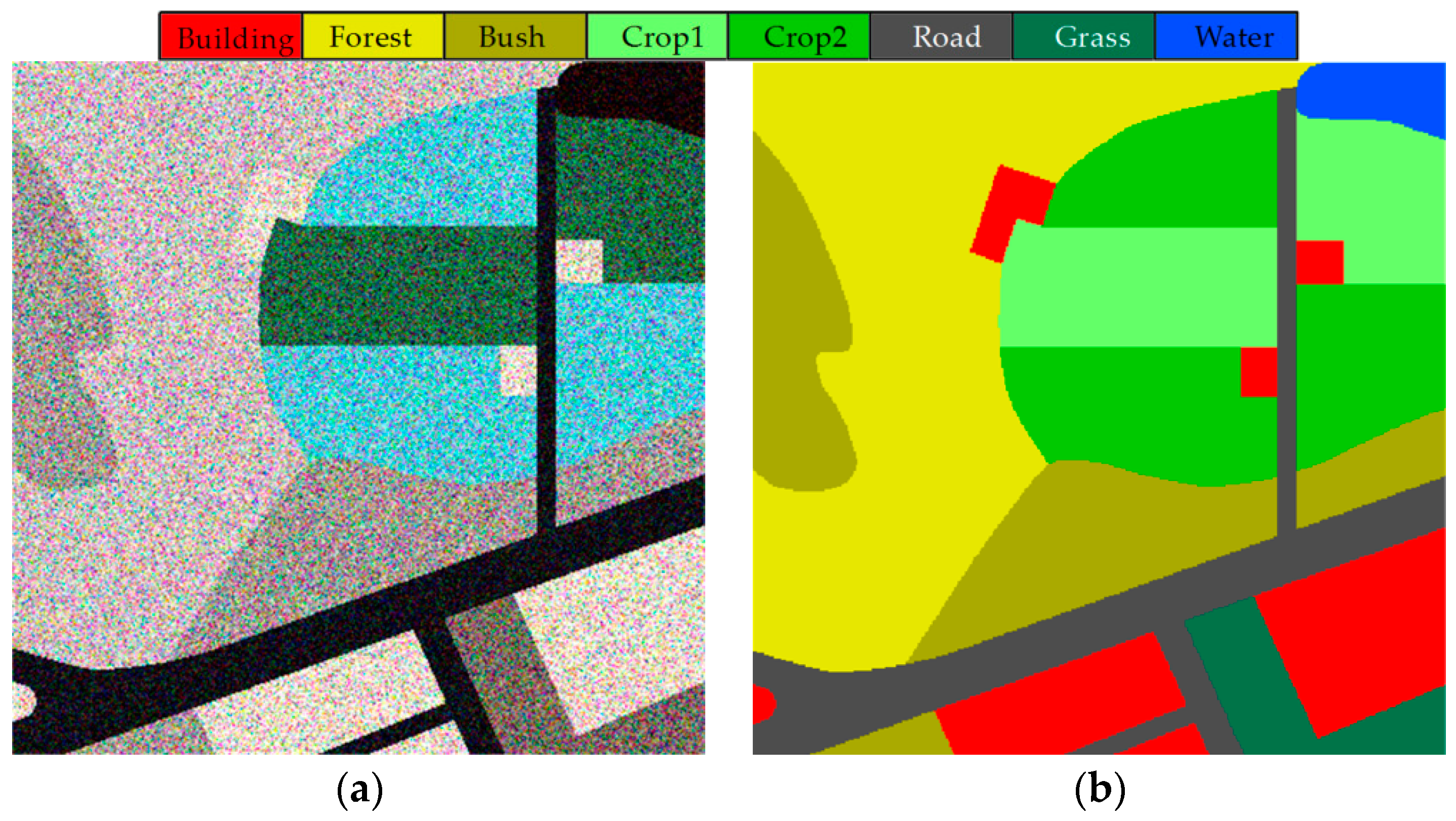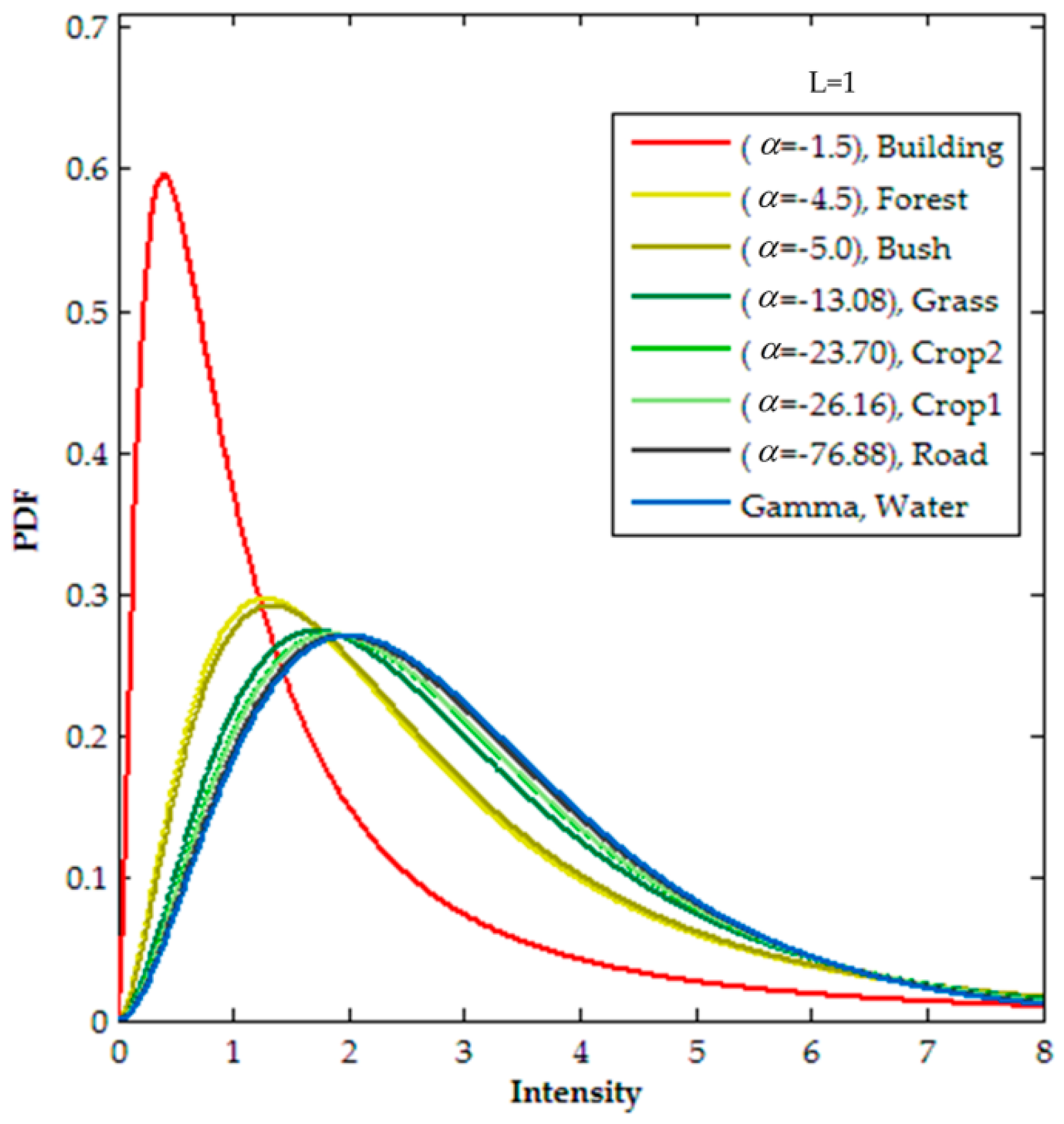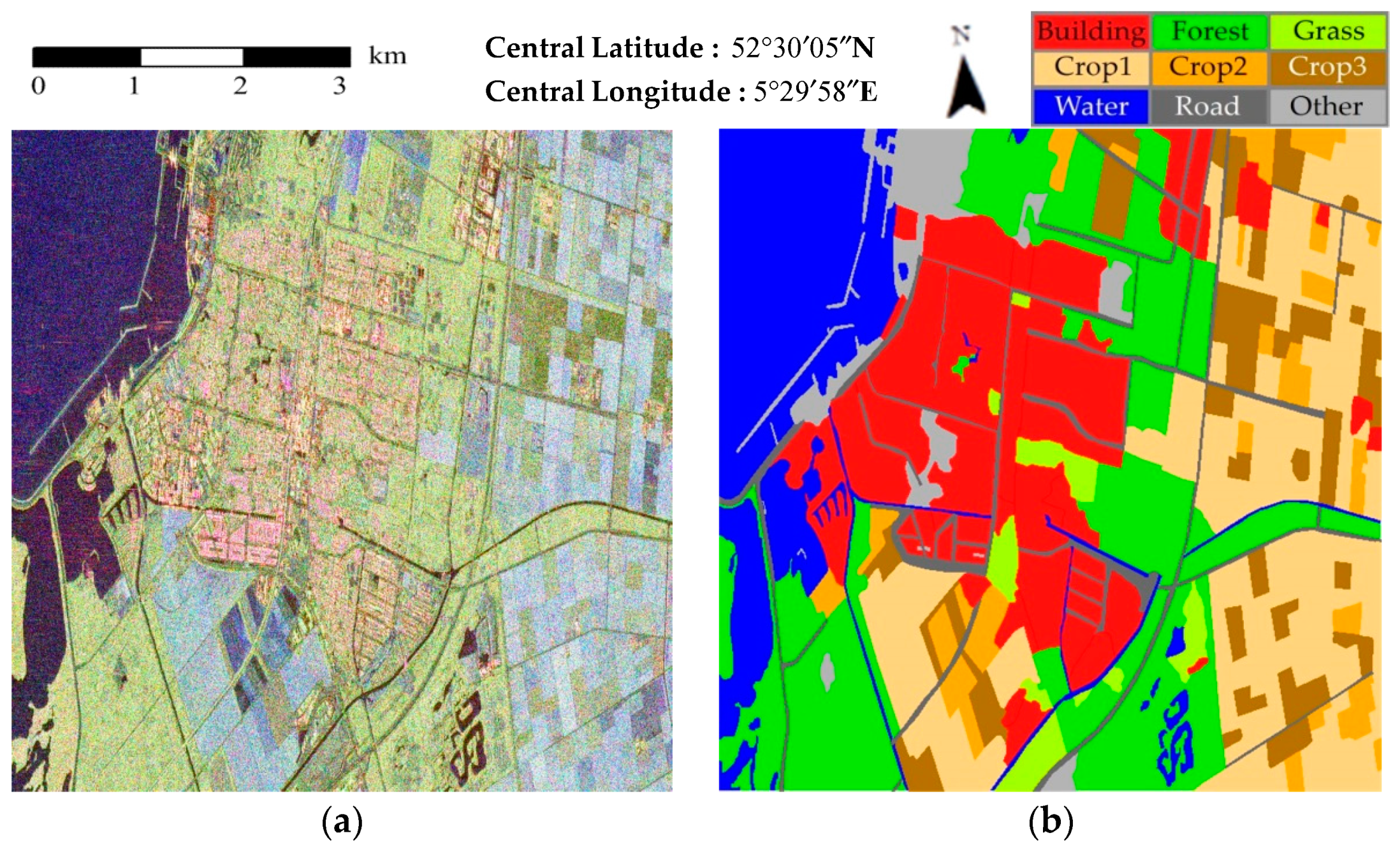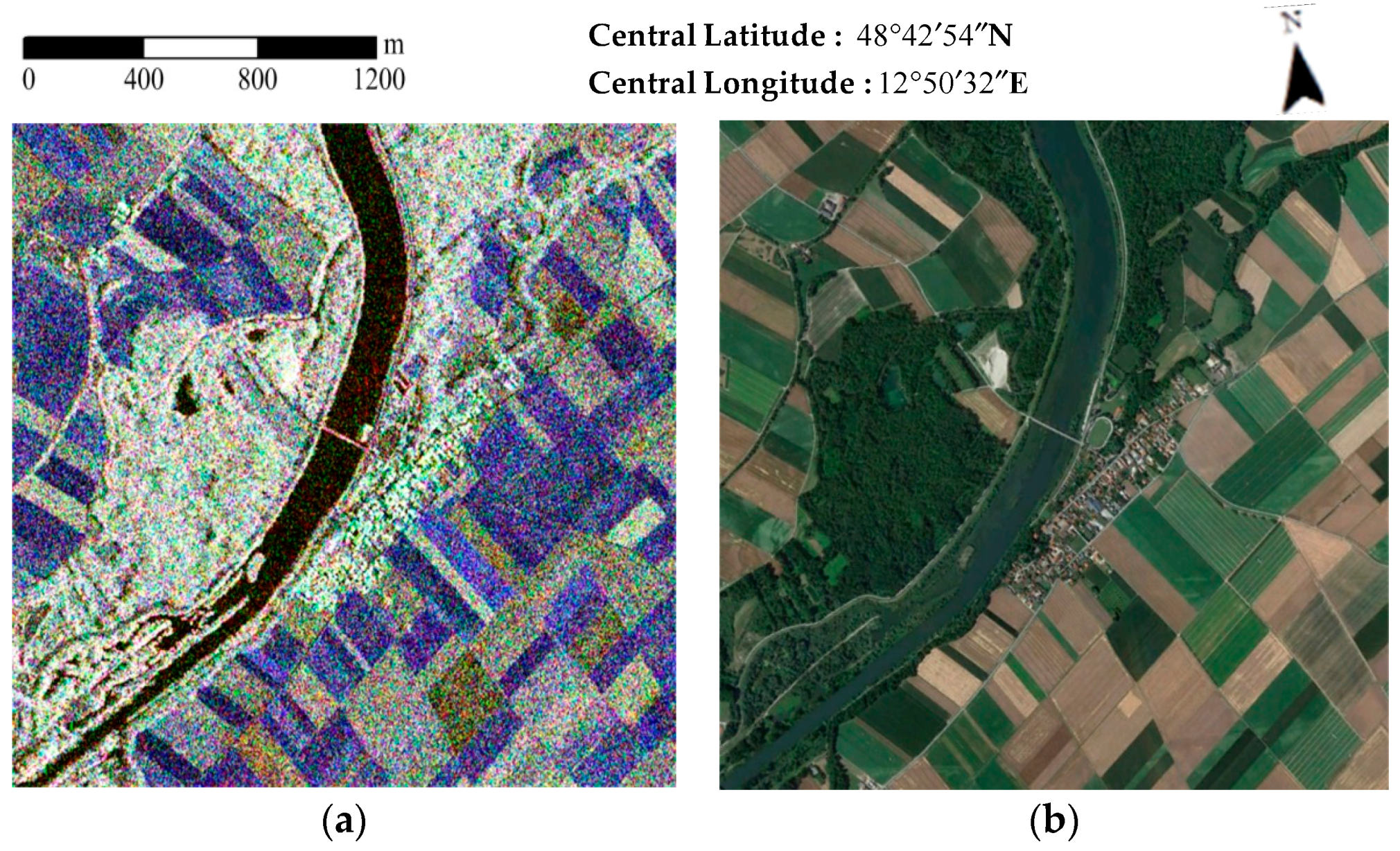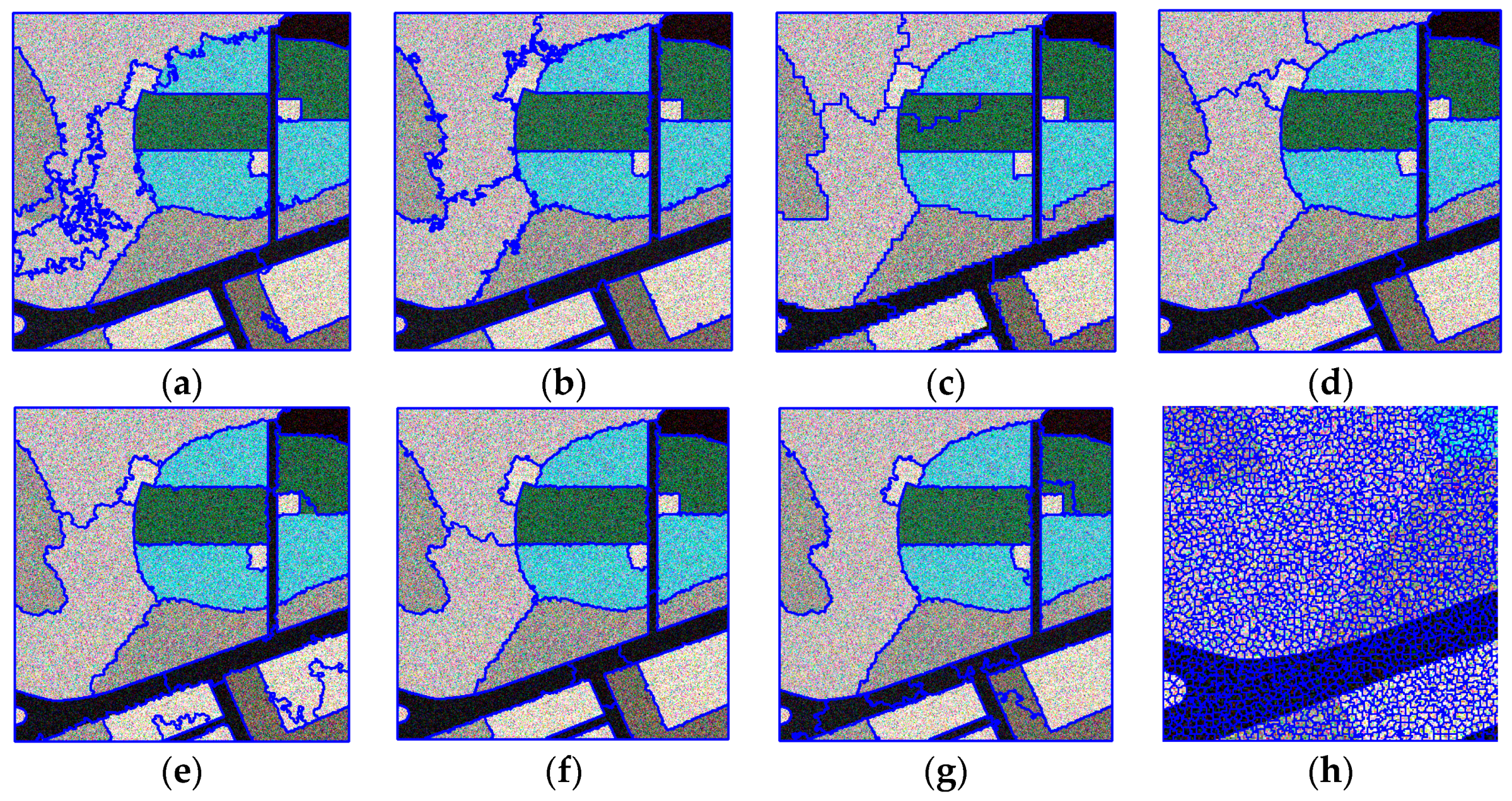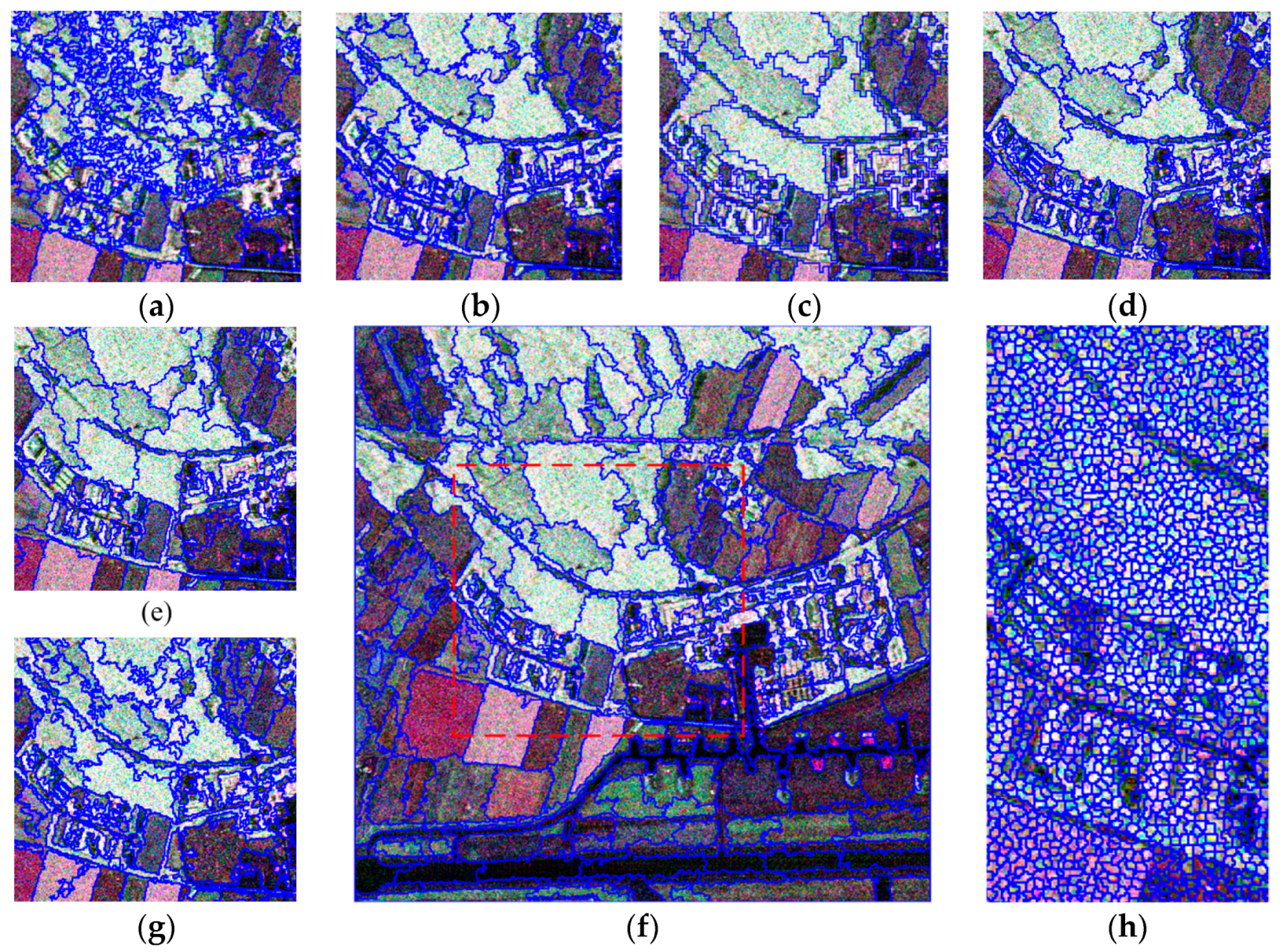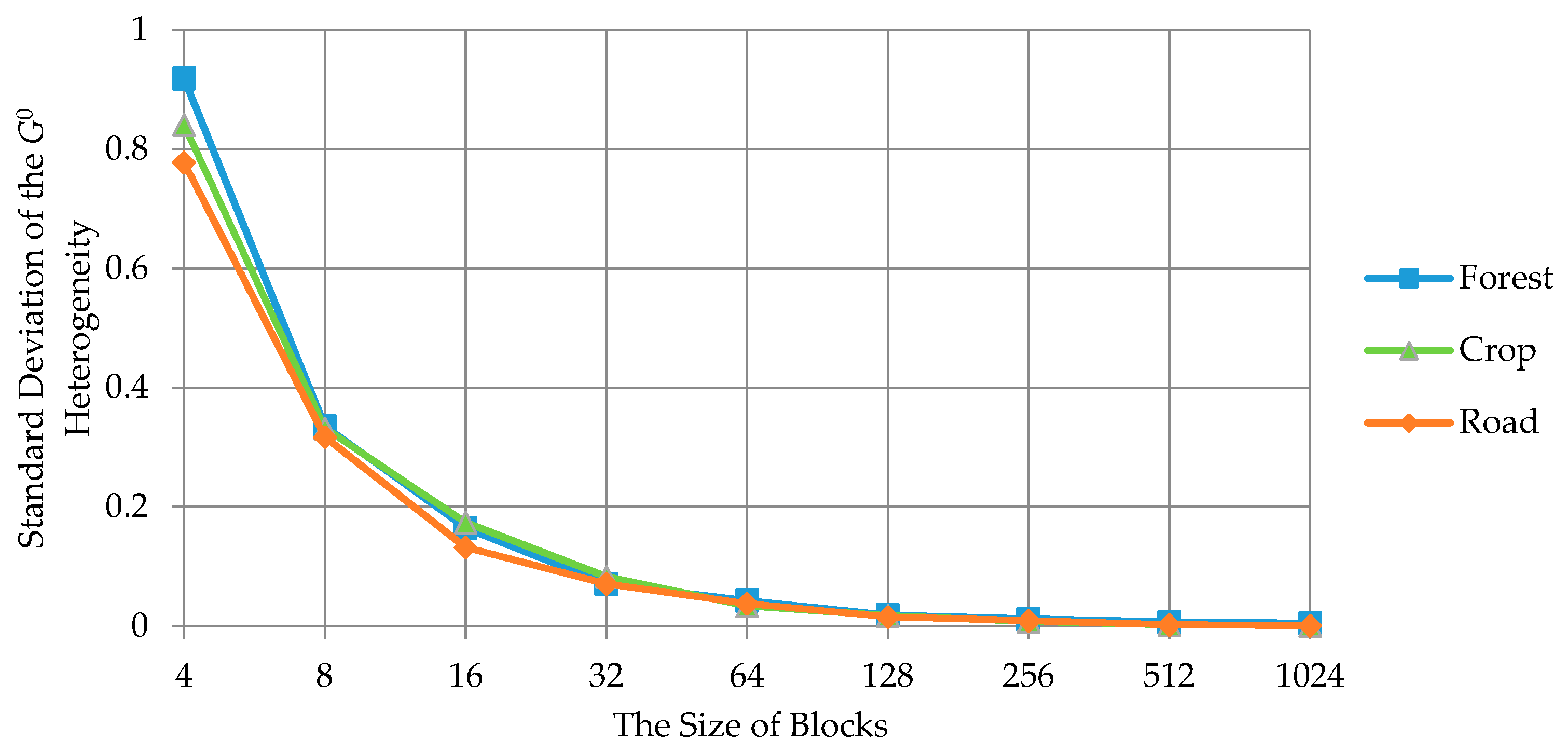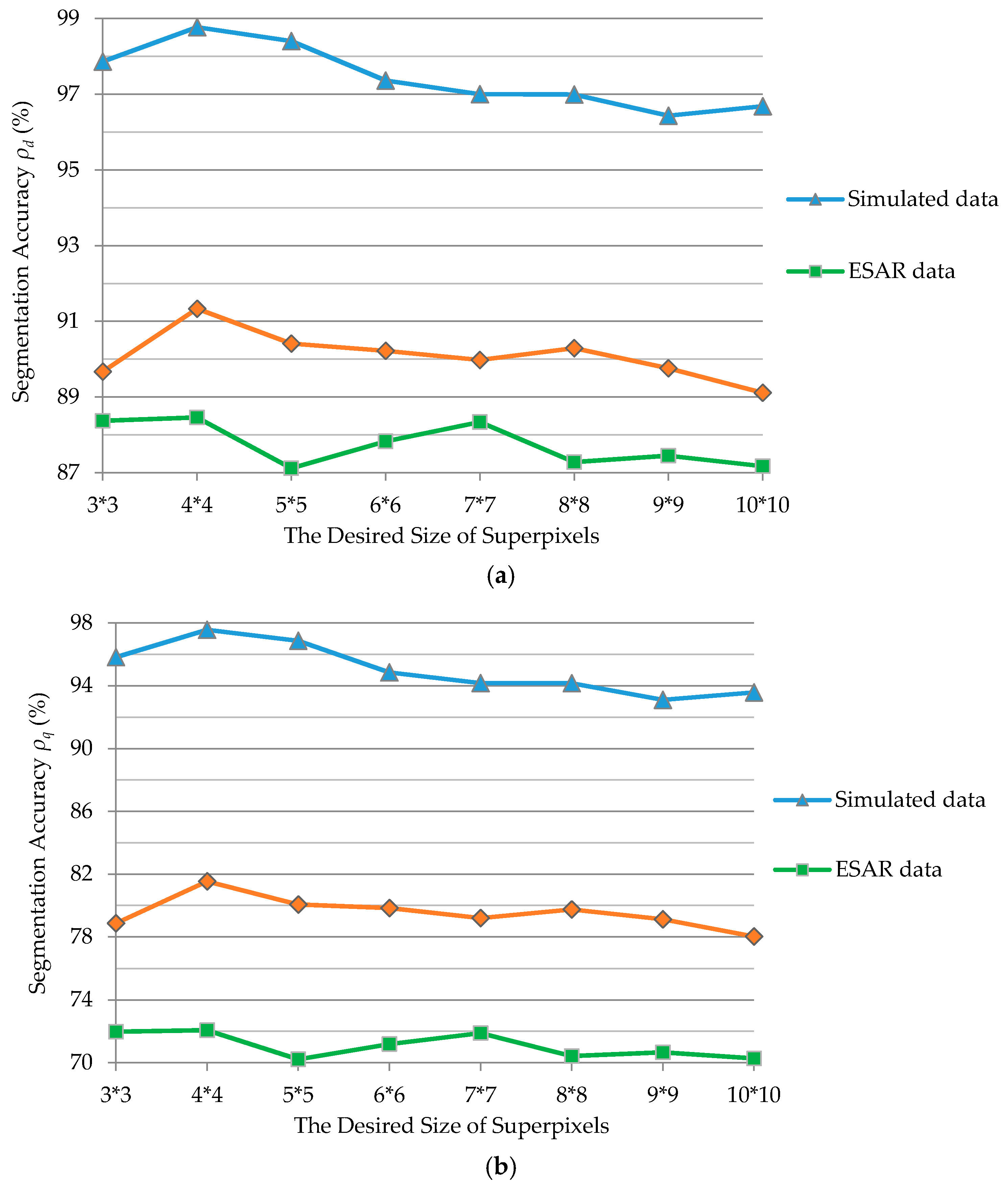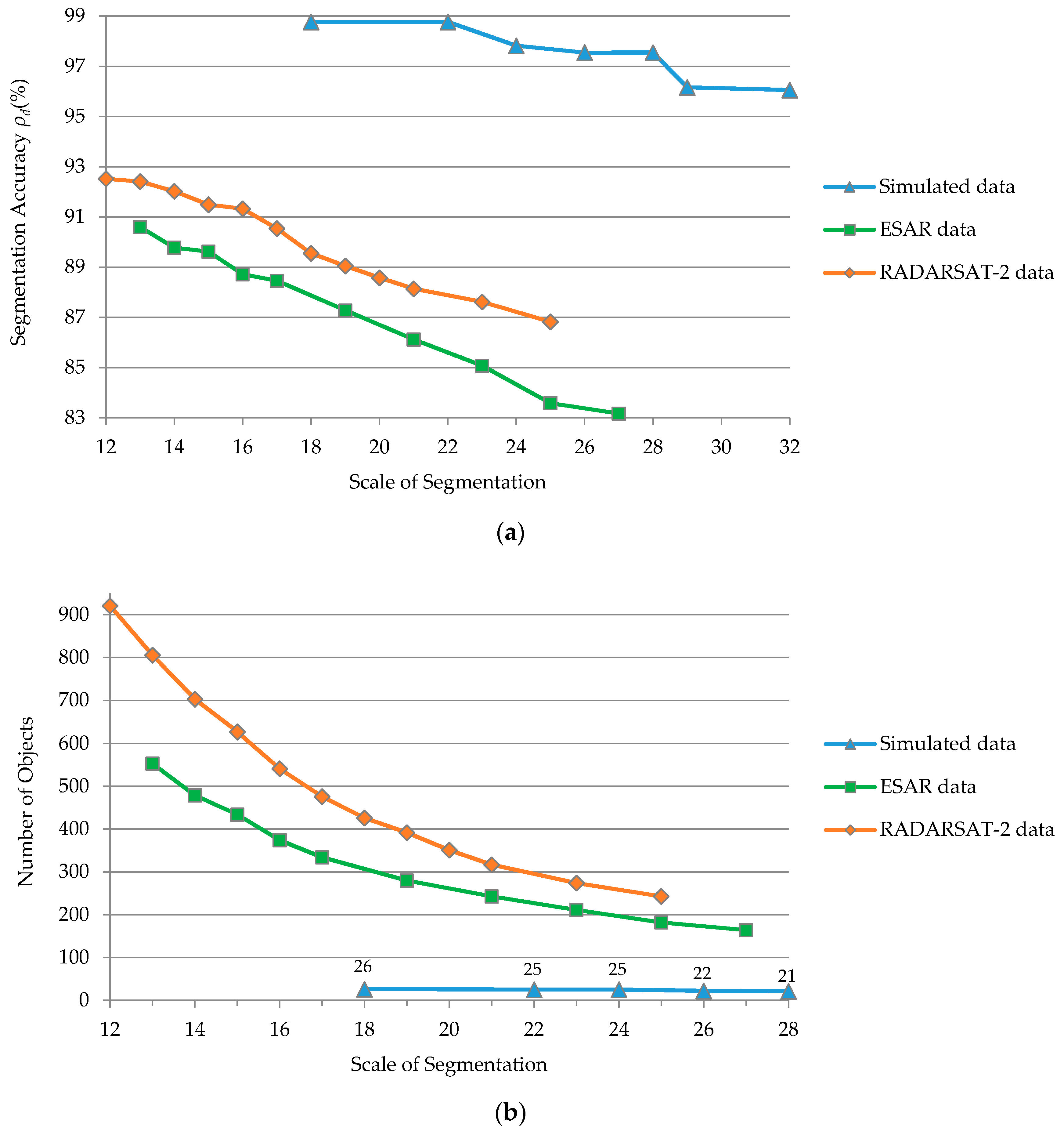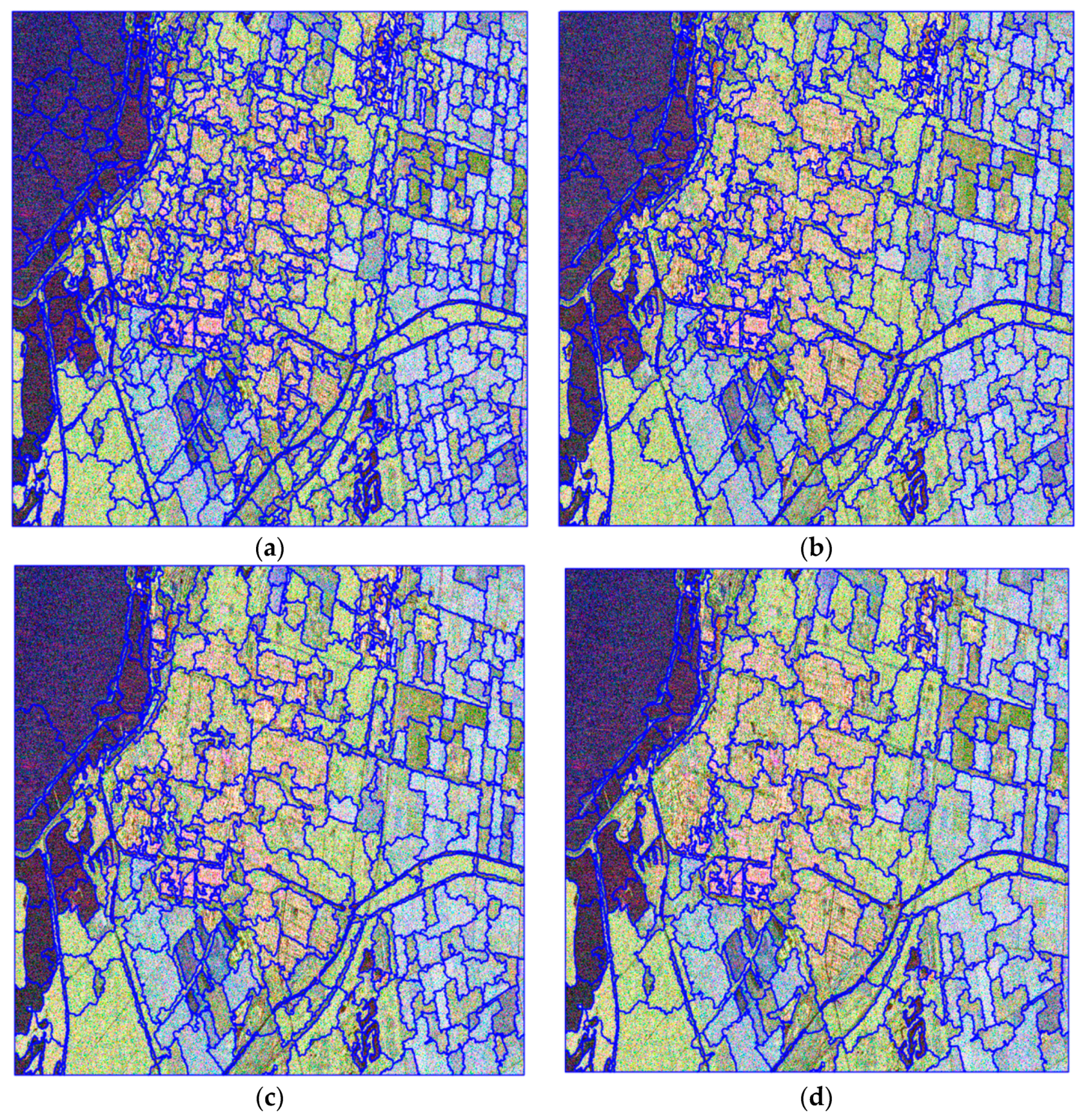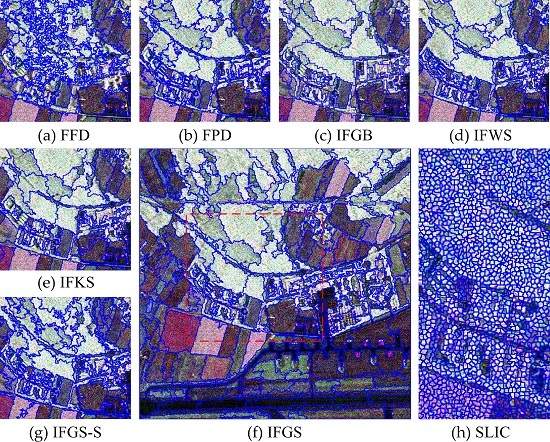To verify the proposed method, one simulated data set, and three different real-world PolSAR data sets are used in the rest of this section. Moreover, different segmentation methods were adopted for comparison. This section is divided into two subsections to describe the experimental data sets and report on the experimental details of the simulated PolSAR data, RADARSAT-2 image, ESAR image, and TerraSAR-X image.
3.1. Description of the Experimental Data Sets
The first data set is a simulated single-look PolSAR image, 400 × 400 pixels in size, and contains eight different classes: Building areas, forest, bush land, grass land, two different types of crops, road, and a water body. To better reflect the ground reality, the Wishart distribution was adopted to generate the water body, while the
G0 distribution data were adopted to generate the other classes. The initial scattering vectors and distribution parameters were estimated from a real data set. The Pauli RGB image is shown in
Figure 1a, and the corresponding reference map is shown in
Figure 1b.
Figure 2 depicts the theoretical PDF of each class.
The second data set is a section of the single-look C-band RADARSAT-2 PolSAR image of Northern Flevoland, Netherlands, and has a spatial resolution of 4.7 m × 4.8 m (range × azimuth). The experimental image is 1400 × 1400 pixels in size and is shown in
Figure 3a. The major land cover classes include homogeneous areas (such as water bodies and farmlands), and heterogeneous areas (such as forest and urban areas). A manual interpretation using nine categories was used as the ground truth map, which is shown in
Figure 3b.
The third data set is a section of the two-look processed L-band ESAR PolSAR image of Oberpfaffenhofen, Germany, and has a spatial resolution of 1.5 m × 1.8 m (range × azimuth). The experimental image is 800 × 800 pixels in size and is shown in
Figure 4a. The major land cover classes include homogeneous areas (such as roads, grasslands, and farmlands) and heterogeneous areas (such as forests and urban areas). A manual interpretation using 16 categories was used as the ground truth map, which is shown in
Figure 4b.
The fourth data set is obtained from a subset of an X-band TerraSAR-X PolSAR image of Deggendorf, German, which is six-look, with a spatial resolution of about 5.0 m × 4.8 m (range × azimuth). The experimental image, with a size of 541 × 541 pixels, is shown in
Figure 5a. The major land cover classes include homogeneous areas (such as river and farmlands) and heterogeneous areas (such as forests and building areas). The corresponding optical image is shown in
Figure 5b.
3.2. Evaluation and Comparison
To verify the improvement in segmentation accuracy by integrating the G0 statistical features into the FNEA framework and pre-segmenting using SLIC, segmentation experiments were performed using different methods, namely: (a) FNEA segmentation based on Freeman decomposition without SAR statistical features (FFD); (b) FNEA segmentation with Pauli RGB image without SAR statistical features (FPD); (c) improved FNEA with G0 statistical features start from square blocks (IFGB); (d) improved FNEA using Wishart statistical features with pre-segmenting by SLIC (IFWS); (e) improved FNEA using K statistical features with pre-segmenting by SLIC (IFKS); (f) improved FNEA using the G0 statistical features with pre-segmenting by SLIC (IFGS); and (g) segmentation using the G0 statistical features without shape features based on SLIC pre-segmenting (IFGS-S).
In addition to qualitative visual assessment, the quality of segmentation results requires an evaluation criterion. Various accuracy metrics describe the similar aspects of the correspondence between reference objects and segments [
44,
45], such as the difference in area between reference objects and the segments they intersect as well as the positional difference between reference objects and segments. In this paper, area-based measures were used to evaluate the accuracy of the segmentation results. Let
R denote the reference segments that consists of regions representing ground objects, and
S denote segmentation result from the processed SAR image. Two area-based metrics are defined as follows:
where
is the area rate of correct segmentation, i.e., detection rate, and
is the degree of overlap between
R and
S (i.e., quality rate), which takes the false positive rate into consideration. These metrics are continuous in [0, 1], and the higher values of these metrics mean better segmentation results. Given that serious over-segmentation may also result in a high segmentation accuracy, the total number of objects (TN) was introduced as an auxiliary evaluation criterion. In general, the number of objects should be as small as possible, in the case of satisfying accuracy requirements.
The segmentation results and accuracy measures of the simulated images using the different methods are shown in
Figure 6 and
Table 1, respectively. In
Figure 6, the blue lines represent the boundaries of the segmentation results, and the background is the Pauli RGB image.
Figure 6d shows the local details in the lower left part of the superpixel map, which was produced using SLIC with 4 × 4 pixels, in the desired size of the superpixel.
As shown in
Table 1, the proposed IFGS method obtained the best detection and quality rates with the least number of generated objects, while the FFD method had the worst segmentation results. For the FFD method, inaccurate segmentation boundaries appeared, especially for classes with similar polarimetric features (
Figure 6a). The results of the Pauli-based FPD method is greatly affected by speckle noise, which causes blurred segmentation boundaries between classes of crops, bush land, forest, and building areas (
Figure 6b). As shown in
Figure 6c–f, the class boundaries became more accurate when statistical information was utilized. However, the Wishart-based IFWS method is not applicable to heterogeneous areas like forests and urban areas. The
K-based IFKS method had inaccurate segmentation results in extreme heterogeneous building areas, as shown in the bottom part of
Figure 6e. In contrast, the
G0-based IFGS method obtained the best segmentation results for the areas with different degrees of heterogeneity, with a 98.77% detection rate and a 97.57% quality rate. The contrast between
Figure 6c,f demonstrates that dentate boundaries appear when square blocks are taken as the initial samples for the statistical model. The boundaries of straight roads or other regular areas deviated. Compared to the IFGS method, the IFGS-S method obtained the wrong segmentation boundaries in partial regular building areas, due to the absence of utilizing the shape features as shown in
Figure 6g. In conclusion, the proposed superpixel-based IFGS method, utilizing the
G0 distribution and shape features, obtained accurate and precise segmentation boundaries for the different areas.
The segmentation results and superpixel map of single-look RADARSAT-2 and two-look ESAR PolSAR images, using these different methods are shown in
Figure 7 and
Figure 8, respectively. In
Figure 7 and
Figure 8, the blue lines represent the boundaries of the segmentation results, and the background is a Pauli RGB image. The superpixel maps of the RADARSAT-2 and ESAR images were produced using SLIC, with 4 × 4 pixels, in the desired size of the superpixel. The segmentation accuracies are presented in
Table 2 and
Table 3, respectively.
For the single-look RADARSAT-2 image, the proposed IFGS method also obtained optimal segmentation results. The contrast between
Figure 7a,b and
Figure 7c–f demonstrated that the utilization of statistical information helped to suppress the influence of the speckle noise, and generated accurate class boundaries. The segmentation results in
Figure 7c,f certify that the superpixel-based method could avoid serrated boundaries. Moreover, the detection rate and quality rate of the IFGS method increased by approximately 1% and 1.4%, compared to the IFGB method, according to
Table 2, which validated the effectiveness of the superpixels. As shown in
Figure 7d–f and
Table 2, the Wishart-based IFWS method obtained seriously fragmented results in areas of high heterogeneity, like the city areas located in the upper right of
Figure 7d, and the
K-based IFKS method had difficulty segmenting the small rivers accurately. Compared to the IFGS method, the IFGS-S method achieved blurred segmentation boundaries in urban areas, forest, and water areas due to the absence the shape feature. In summary, employing shape features and statistics information comprehensively contributed to generating better segmentation results. According to
Table 2, the proposed superpixel-based IFGS method obtained the highest accuracy with the least number of segmentation objects, and the detection rate and quality rate were 91.33% and 81.53%, respectively. The above-mentioned results indicate that the proposed method is applicable to single-look high-resolution PolSAR images.
For the multi-look ESAR image, the proposed IFGS method still obtained optimal segmentation results. As shown in
Figure 8a,b, the segmentation results of the FFD and FPD methods, which utilized polarimetric decomposition features, were greatly affected by the speckle noise, resulting in blurred segmentation boundaries. In contrast, the statistics-based segmentation method suppressed the influence of speckle noise and achieved more accurate segmentation boundaries between the different classes, as shown in
Figure 8c–f. However, when the square blocks were taken as initial samples for the statistical models, serrated and inaccurate segmentation boundaries occurred, as shown in
Figure 8c. The contrast between
Figure 8d–f certifies that the
G0-based IFGS method obtained better segmentation results (such as for roads in the forest) than the Wishart-based IFWS or the
K-based IFKS method. For the IFGS-S method, the blurred segmentation boundaries occurred in areas with little change in statistics and polarimetric information, especially for the inner areas of forest, urban, and farmland in
Figure 8g. According to
Table 3, the proposed IFGS method obtained the highest accuracy with the least number of segmentation objects, similar to that of the single-look RADARSAT-2 image. Specifically, the detection and quality rates of the IFGS method were 88.46% and 72.07%, respectively. This demonstrates the effectiveness of the proposed method for multi-look high-resolution PolSAR images.
In order to further validate the effectiveness of the proposed method, the segmentation results of the third set of ESAR data, generated using the GSRM method [
5] and the MW-WMRF method [
15] were used as comparison.
Figure 9a,b demonstrates the representation maps of the GSRM method and the MW-WMRF method, respectively. The Pauli RGB of each pixel was replaced by the average Pauli RGB of the segment that the pixel belonged to. Similarly,
Figure 9c,d gives the representation maps of the proposed method at different scales. Specifically, a number of isolated small segments occurred in heterogeneous areas like forest (area A of
Figure 9a) and urban areas (area B of
Figure 9a) for the GSRM method, which decreased the visibility and accuracy of the representation map. As for the MW-WMRF method, the segmentation results of urban areas were broken due to the utilization of the Wishart distribution, which is shown in area B of
Figure 9b. The boundaries between the different types of farmlands for these two methods were inaccurate (area C of
Figure 9a,b). The boundaries for forests of different height were not accurate enough (area A of
Figure 9a,b). In contrast, accurate boundaries of farmlands and forest were obtained, with different segmentation scales, for the proposed method (area A and area C of
Figure 9c,d), and the urban areas were entirely segmented (area B of
Figure 9c,d). Furthermore, the detection rates of the GSRM, MW-WMRF, and IFGS (
t = 13) method were 87.86%, 90.20%, and 90.60%, respectively. In summary, the proposed method obtained better segmentation results compared to the GSRM method and the MW-WMRF method.
For the X-band multi-look TerraSAR-X image, the proposed IFGS method also performed well. As shown in
Figure 10, the river, bridge, lakes, and building areas in the southeastern area of the river were all accurately segmented. Accurate and delicate boundaries of different types of farmlands and of the inner area of the forest were achieved. Compared to
Figure 10a, the segmentation results in
Figure 10b were more precise and obtained a higher quantity of objects when the segmentation scale decreased to 12. This experiment further demonstrated the applicability of the proposed method for high-resolution PolSAR images.
